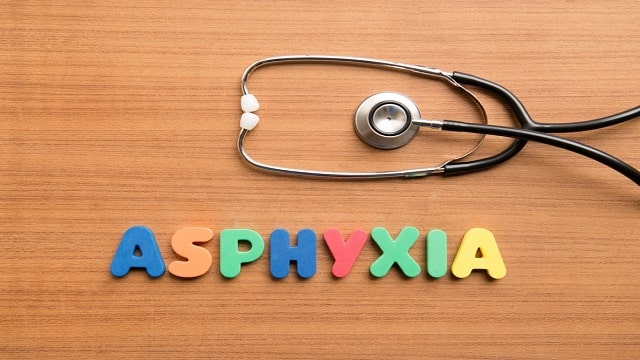Asphyxia is a condition where the oxygen level in the body decreases. If not treated immediately, this condition can cause loss of consciousness, brain injury, or death.
Asphyxia can occur during labor. This is also called birth asphyxia or perinatal asphyxia. In this case, blood flow or oxygen to the fetus is insufficient. Perinatal asphyxia can occur before, during, or after labor. However, most cases occur during the labor process.
Symptoms of Asphyxia
Common symptoms of asphyxia include:
- Hoarse voice.
- Sore throat.
- Difficulty swallowing.
- Hard to breathe.
- Hyperventilation.
- Worsening of existing asthma.
- Emergency.
- Poor concentration.
- Headache.
- Blurred or reduced vision.
- Loss of consciousness.
Meanwhile, babies who experience prenatal asphyxia may have:
- Pale or bluish skin.
- Slow heart rate.
- Weak reflexes.
- His cry was weak.
- Panting.
Causes of Asphyxia
There are many things that can cause asphyxia, including:
- Drowning
When a person drowns, they cannot breathe because they are taking in water. As a result, their body cannot deliver oxygen to their tissues and organs.
- Chemical asphyxia
This occurs when a person inhales a substance that can cut off the body’s oxygen supply, either by replacing oxygen in the lungs, or interfering with the delivery of oxygen in the blood. One example of a chemical that can cause asphyxia is carbon monoxide, an odorless, colorless gas found in smoke.
- Anaphylaxis
Anaphylaxis is a severe allergic reaction to food, drugs, or insect stings. This allergic reaction can cause swelling in the upper airways. If not treated immediately, the swelling can get worse and interfere with breathing.
During a severe asthma attack, the airways can swell and narrow. Without immediate treatment, the airways can become too narrow and cut off the oxygen supply.
- The airway is blocked by a foreign object
When choking, a foreign object gets stuck in the airway making it difficult for a person to breathe oxygen.
- Strangulation
When strangled by hands, ligatures, or other objects, this can also make it difficult for a person to breathe, so that oxygen levels in the body will slowly decrease.
Meanwhile, several things that can cause birth asphyxia include:
- Lack of oxygen in the mother’s blood.
- Reduced breathing in the mother due to anesthesia.
- Fever or low blood pressure in the mother.
- Umbilical cord compression.
- Poor placental function.
- Placental abruption.
- Uterine rupture.
Risk Factors for Asphyxia
Here are some groups of people who are at higher risk of experiencing asphyxia:
- Asthma sufferers.
- People who have allergies.
- Baby.
- People with respiratory problems.
- People who have difficulty swallowing.
Meanwhile, several things that can increase the risk of a baby experiencing perinatal asphyxia include:
- The mother who gave birth is 20-25 years old.
- The baby was born prematurely.
- The mother who gave birth experienced a fever during labor.
Diagnosis of Asphyxia
Asphyxia can actually be known by observing the symptoms. However, in infants, here are some tests that can be done to diagnose prenatal asphyxia:
- Severe acidity, i.e. pH less than 7.00, in the umbilical cord arterial blood.
- Apgar score from zero to three over five minutes. The Apgar test is used right after birth to evaluate a newborn’s color, heart rate, reflexes, muscle tone, and breathing.
- Neurological problems, such as seizures, coma, and poor muscle tone.
- Trouble breathing, low blood pressure, or other signs of low blood flow to the kidneys or intestines.
- Problems with the baby’s circulatory, digestive, and respiratory systems can also indicate that the baby experienced birth asphyxia.
Complications of Asphyxia
Complications of asphyxia can occur after a person regains consciousness. Damage can occur to organs, the heart, lungs, and the nervous system. Orthopedic damage can also occur in cases of strangulation or hanging.
A 2020 study suggested that there may be a link between perinatal asphyxia, or asphyxia during childbirth, and cerebral palsy. However, more research is needed to prove this.
Asphyxia Treatment
Treatment for asphyxia depends on the cause. It may include:
- Cardiopulmonary resuscitation (CPR). CPR is a procedure that involves chest compressions to improve blood and oxygen circulation. It is used when a person’s heart stops beating.
- Heimlich Maneuver. This is a first-aid technique for choking. The Heimlich Maneuver involves pushing on the abdomen below the diaphragm to dislodge a foreign object from a person’s airway.
- Oxygen therapy. Oxygen therapy delivers oxygen to the lungs. This may involve a ventilator, breathing tube, or a mask or nasal tube that delivers oxygen.
- Medications. Medications can help relieve the effects of an allergic reaction, severe asthma attack, or drug overdose. For example, epinephrine (EpiPen) can quickly treat anaphylaxis.
Prevention of Asphyxia
Prevention of asphyxia can also vary depending on the cause. Here are some prevention techniques based on the cause:
- Learn some self-defense techniques to escape from someone’s grip or strangulation.
- Parents and caregivers should keep small objects out of reach of children to prevent choking which can cause asphyxia.
- Learn to swim and avoid swimming in open waters where the currents are unknown.
- People with allergies should avoid things they know can trigger an allergic reaction. Also, always carry an EpiPen with you when you leave the house.
- The U.S. Centers for Disease Control and Prevention (CDC) lists a number of ways to prevent carbon monoxide poisoning. These include regularly servicing gas, oil, or coal-burning appliances, installing carbon monoxide detectors, and not running cars or trucks in an attached garage.
- People with asthma should always carry their inhaler with them.

